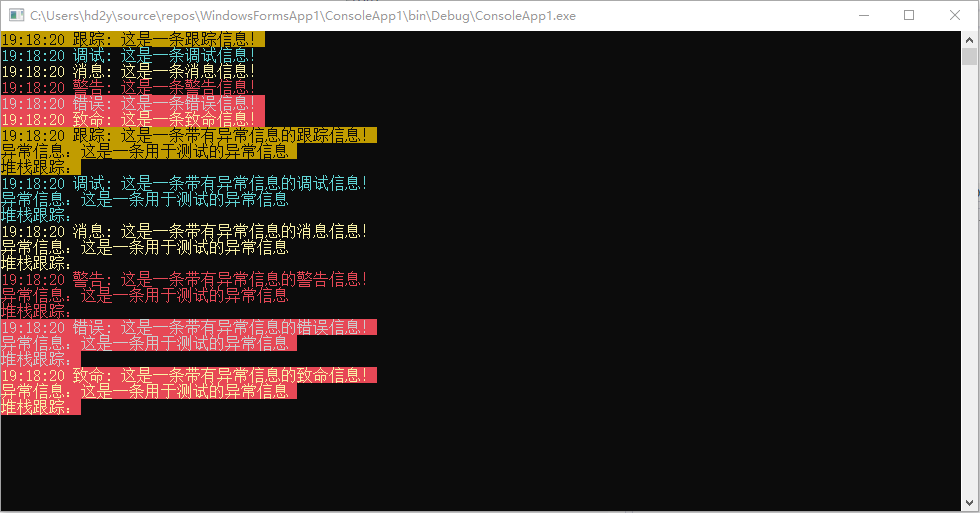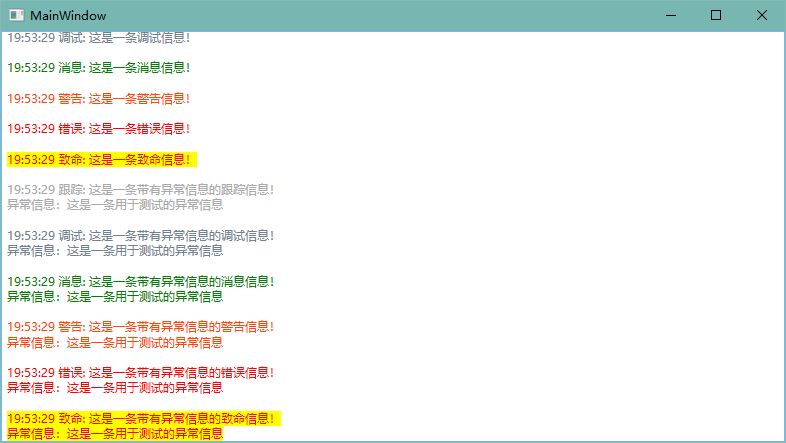
前言
稍大一些的系统设计,日志模块我们一般都会选用 log4net 或 NLog,开源并且功能齐全,配置功能很好用。
但是偶尔我们也会开发一些小工具,只是简单的输出一些日志,如果再选择这些开源项目的方案,不免显得有点“沉重”。
后面就针对这简单的使用场景,写了一个“简陋”的工具类 Logger.cs 满足一些简单场景的使用。
源代码
不说废话,直接看代码:
using System;
using System.Collections.Generic;
using System.ComponentModel;
using System.IO;
using System.Linq;
using System.Reflection;
using System.Text;
namespace JohnSun.Utility
{
/// <summary>
/// 日志输出方式
/// </summary>
[Flags]
public enum LogType
{
None = 0,
File = 1,
Console = 2,
All = 3
}
/// <summary>
/// 日志 严重性
/// </summary>
[Flags]
public enum LogLevel
{
[Description("None")]
None = 0,
[Description("跟踪")]
Trace = 1,
[Description("调试")]
Debug = 2,
[Description("消息")]
Info = 4,
[Description("警告")]
Warn = 8,
[Description("错误")]
Error = 16,
[Description("致命")]
Fatal = 32,
[Description("All")]
All = 63
}
/// <summary>
/// 日志
/// </summary>
public class Logger
{
private static readonly Dictionary<LogLevel, string> _logLevelDescription = new Dictionary<LogLevel, string>();
/// <summary>
/// 日志等级的描述信息
/// </summary>
public static Dictionary<LogLevel, string> LogLevelDescription
{
get
{
if (_logLevelDescription.Count == 0)
{
Array values = Enum.GetValues(typeof(LogLevel));
foreach (object value in values)
{
LogLevel level = (LogLevel)value;
FieldInfo info = typeof(LogLevel).GetField(level.ToString());
object[] attrs = info.GetCustomAttributes(false);
if (attrs.ToList().Find(attr => attr is DescriptionAttribute) is DescriptionAttribute attribute)
{
_logLevelDescription[level] = attribute.Description;
}
else
{
_logLevelDescription[level] = level.ToString();
}
}
}
return _logLevelDescription;
}
}
/// <summary>
/// 设置日志记录等级
/// </summary>
public static LogLevel LogLevel { get; set; } = LogLevel.All;
/// <summary>
/// 日志输出方式
/// </summary>
public static LogType LogType { get; set; } = LogType.File;
private static void LogToConsole(string message, ConsoleColor textColor)
{
Console.OutputEncoding = Encoding.UTF8;
Console.ForegroundColor = textColor;
Console.WriteLine(message);
Console.ResetColor();
Console.OutputEncoding = Encoding.Default;
}
private static void LogToConsole(string message, ConsoleColor textColor, ConsoleColor backColor)
{
Console.OutputEncoding = Encoding.UTF8;
Console.ForegroundColor = textColor;
Console.BackgroundColor = backColor;
Console.Write(message);
Console.ResetColor();
Console.WriteLine();
Console.OutputEncoding = Encoding.Default;
}
static void LogToConsole(LogLevel v, string message)
{
switch (v)
{
case LogLevel.Trace:
LogToConsole(message, ConsoleColor.Black, ConsoleColor.DarkYellow);
break;
case LogLevel.Debug:
LogToConsole(message, ConsoleColor.Cyan);
break;
case LogLevel.Info:
LogToConsole(message, ConsoleColor.Yellow);
break;
case LogLevel.Warn:
LogToConsole(message, ConsoleColor.Red);
break;
case LogLevel.Error:
LogToConsole(message, ConsoleColor.Gray, ConsoleColor.Red);
break;
case LogLevel.Fatal:
LogToConsole(message, ConsoleColor.Yellow, ConsoleColor.Red);
break;
}
}
private static readonly object _sync = new object();
static void LogToFile(LogLevel v, string message)
{
string directory = Path.Combine(AppDomain.CurrentDomain.BaseDirectory, "Logs");
string path = Path.Combine(directory, DateTime.Now.ToString("yyyy-MM-dd") + ".txt");
lock (_sync)
{
if (!Directory.Exists(directory))
{
Directory.CreateDirectory(directory);
}
File.AppendAllText(path, message, Encoding.UTF8);
}
}
static void Log(LogLevel v, string message, Exception exception = null)
{
if ((v & LogLevel) == 0)
return;
if ((LogType & LogType.Console) != 0)
LogToConsole(v, $"{DateTime.Now.ToString("HH:mm:ss")} {LogLevelDescription[v]}: {message}{(exception == null ? "" : $"\r\n异常信息:{exception.Message} {exception.InnerException?.Message}\r\n堆栈跟踪:{exception.StackTrace}")}");
if ((LogType & LogType.File) != 0)
LogToFile(v, $"{DateTime.Now.ToString("HH:mm:ss")} {LogLevelDescription[v]}: {message}{(exception == null ? "" : $"\r\n异常信息:{exception.Message} {exception.InnerException?.Message}\r\n堆栈跟踪:{exception.StackTrace}")}\r\n");
LogEvent?.Invoke(v, message, exception);
}
/// <summary>
/// 跟踪
/// </summary>
/// <param name="message"></param>
/// <param name="exception"></param>
public static void Trace(string message, Exception exception = null) => Log(LogLevel.Trace, message, exception);
/// <summary>
/// 调试
/// </summary>
/// <param name="message"></param>
/// <param name="exception"></param>
public static void Debug(string message, Exception exception = null) => Log(LogLevel.Debug, message, exception);
/// <summary>
/// 消息
/// </summary>
/// <param name="message"></param>
/// <param name="exception"></param>
public static void Info(string message, Exception exception = null) => Log(LogLevel.Info, message, exception);
/// <summary>
/// 警告
/// </summary>
/// <param name="message"></param>
/// <param name="exception"></param>
public static void Warn(string message, Exception exception = null) => Log(LogLevel.Warn, message, exception);
/// <summary>
/// 错误
/// </summary>
/// <param name="message"></param>
/// <param name="exception"></param>
public static void Error(string message, Exception exception = null) => Log(LogLevel.Error, message, exception);
/// <summary>
/// 致命
/// </summary>
/// <param name="message"></param>
/// <param name="exception"></param>
public static void Fatal(string message, Exception exception = null) => Log(LogLevel.Fatal, message, exception);
/// <summary>
/// 日志记录
/// </summary>
/// <param name="v">日志等级</param>
/// <param name="message">消息</param>
public delegate void LogAction(LogLevel v, string message, Exception exception = null);
/// <summary>
/// 日志记录事件
/// </summary>
public static event LogAction LogEvent;
}
}
默认提供了两种日志的输出方式,可以通过标识枚举 LogType 控制,可以输出到文件或输出到控制台。
默认提供了六种日志严重程度,可以通过标识枚举 LogLevel 控制输出哪些类型的日志。
如果这些不能满足需求,例如有将日志输出到 Windows Form、WPF、数据库等的需求,可以通过注册 LogEvent 事件实现。
常规用法
默认提供了写文件与输出到控制台的用法,可以参考以下例子:
// 设置日志输出方式
Logger.LogType = LogType.Console | LogType.File; // 等用于 LogType.All
// 设置输出日志的类型
Logger.LogLevel = LogLevel.All; // 这里设置所有日志类型都输出
// 常见输出
Logger.Trace($"这是一条{Logger.LogLevelDescription[LogLevel.Trace]}信息!");
Logger.Debug($"这是一条{Logger.LogLevelDescription[LogLevel.Debug]}信息!");
Logger.Info($"这是一条{Logger.LogLevelDescription[LogLevel.Info]}信息!");
Logger.Warn($"这是一条{Logger.LogLevelDescription[LogLevel.Warn]}信息!");
Logger.Error($"这是一条{Logger.LogLevelDescription[LogLevel.Error]}信息!");
Logger.Fatal($"这是一条{Logger.LogLevelDescription[LogLevel.Fatal]}信息!");
// 带异常信息的输出
Exception exception = new Exception("这是一条用于测试的异常信息");
Logger.Trace($"这是一条带有异常信息的{Logger.LogLevelDescription[LogLevel.Trace]}信息!", exception);
Logger.Debug($"这是一条带有异常信息的{Logger.LogLevelDescription[LogLevel.Debug]}信息!", exception);
Logger.Info($"这是一条带有异常信息的{Logger.LogLevelDescription[LogLevel.Info]}信息!", exception);
Logger.Warn($"这是一条带有异常信息的{Logger.LogLevelDescription[LogLevel.Warn]}信息!", exception);
Logger.Error($"这是一条带有异常信息的{Logger.LogLevelDescription[LogLevel.Error]}信息!", exception);
Logger.Fatal($"这是一条带有异常信息的{Logger.LogLevelDescription[LogLevel.Fatal]}信息!", exception);
Console.ReadKey();
输出到文件的效果,会根据日期创建文件夹:

输出到控制台的效果,不同日志类型设置了不同的颜色用于区分:

注册事件
偶尔会开发一些窗体应用程序,需要将日志输出到窗体控件,这里以输出到富文本框 RichTextBox 为例。
WinForm 用法:
创建一个 RichTextBox 控件用于输出:
// 设置日志输出方式 这里不启用写文件和输出到控制台
Logger.LogType = LogType.None;
// 设置输出日志的类型 因为不用默认输出方式 这里可以不用设置
Logger.LogLevel = LogLevel.All;
// 注册日志输出事件 输出到富文本框
Logger.LogEvent += (level, msg, exc) =>
{
this.Invoke(new Action(() =>
{
string text = $"{DateTime.Now.ToString("HH:mm:ss")} {Logger.LogLevelDescription[level]}: {msg}{(string.IsNullOrEmpty(exc?.Message) ? "" : $"\r\n异常信息:{exc.Message}")}{(string.IsNullOrEmpty(exc?.StackTrace) ? "" : $"\r\n堆栈跟踪:{exc.StackTrace}")}\r\n";
switch (level)
{
case LogLevel.Trace:
richTextBox1.SelectionColor = Color.DarkGray;
break;
case LogLevel.Debug:
richTextBox1.SelectionColor = Color.SlateGray;
break;
case LogLevel.Info:
richTextBox1.SelectionColor = Color.Green;
break;
case LogLevel.Warn:
richTextBox1.SelectionColor = Color.OrangeRed;
break;
case LogLevel.Error:
richTextBox1.SelectionColor = Color.Red;
break;
case LogLevel.Fatal:
richTextBox1.SelectionColor = Color.Red;
richTextBox1.SelectionBackColor = Color.Yellow;
break;
default:
return;
}
richTextBox1.AppendText(text);
}));
};
// 常见输出
Logger.Trace($"这是一条{Logger.LogLevelDescription[LogLevel.Trace]}信息!");
Logger.Debug($"这是一条{Logger.LogLevelDescription[LogLevel.Debug]}信息!");
Logger.Info($"这是一条{Logger.LogLevelDescription[LogLevel.Info]}信息!");
Logger.Warn($"这是一条{Logger.LogLevelDescription[LogLevel.Warn]}信息!");
Logger.Error($"这是一条{Logger.LogLevelDescription[LogLevel.Error]}信息!");
Logger.Fatal($"这是一条{Logger.LogLevelDescription[LogLevel.Fatal]}信息!");
// 带异常信息的输出
Exception exception = new Exception("这是一条用于测试的异常信息");
Logger.Trace($"这是一条带有异常信息的{Logger.LogLevelDescription[LogLevel.Trace]}信息!", exception);
Logger.Debug($"这是一条带有异常信息的{Logger.LogLevelDescription[LogLevel.Debug]}信息!", exception);
Logger.Info($"这是一条带有异常信息的{Logger.LogLevelDescription[LogLevel.Info]}信息!", exception);
Logger.Warn($"这是一条带有异常信息的{Logger.LogLevelDescription[LogLevel.Warn]}信息!", exception);
Logger.Error($"这是一条带有异常信息的{Logger.LogLevelDescription[LogLevel.Error]}信息!", exception);
Logger.Fatal($"这是一条带有异常信息的{Logger.LogLevelDescription[LogLevel.Fatal]}信息!", exception);
日志打印效果:

WPF 用法:
// 设置日志输出方式 这里不启用写文件和输出到控制台
Logger.LogType = LogType.None;
// 设置输出日志的类型 因为不用默认输出方式 这里可以不用设置
Logger.LogLevel = LogLevel.All;
// 注册日志输出事件 输出到富文本框
Logger.LogEvent += new Logger.LogAction((level, msg, exc) =>
{
this.Dispatcher.Invoke((Action)delegate
{
Paragraph paragraph = new Paragraph();
Run run = new Run() { Text = $"{DateTime.Now.ToString("HH:mm:ss")} {Logger.LogLevelDescription[level]}: {msg}{(string.IsNullOrEmpty(exc?.Message) ? "" : $"\r\n异常信息:{exc.Message}")}{(string.IsNullOrEmpty(exc?.StackTrace) ? "" : $"\r\n堆栈跟踪:{exc.StackTrace}")}" };
switch (level)
{
case LogLevel.Trace:
run.Foreground = Brushes.DarkGray;
break;
case LogLevel.Debug:
run.Foreground = Brushes.SlateGray;
break;
case LogLevel.Info:
run.Foreground = Brushes.Green;
break;
case LogLevel.Warn:
run.Foreground = Brushes.OrangeRed;
break;
case LogLevel.Error:
run.Foreground = Brushes.Red;
break;
case LogLevel.Fatal:
run.Foreground = Brushes.Red;
run.Background = Brushes.Yellow;
break;
}
paragraph.Inlines.Add(run);
// 这个新日志将会输出到富文本框的顶部
// if (this.richTextBox1.Document.Blocks.FirstBlock == null)
// {
// this.richTextBox1.Document.Blocks.Add(paragraph);
// }
// else
// {
// this.richTextBox1.Document.Blocks.InsertBefore(this.richTextBox1.Document.Blocks.FirstBlock, paragraph);
// }
// this.richTextBox1.ScrollToHome();
this.richTextBox1.Document.Blocks.Add(paragraph);
this.richTextBox1.ScrollToEnd();
});
});
// 常见输出
Logger.Trace($"这是一条{Logger.LogLevelDescription[LogLevel.Trace]}信息!");
Logger.Debug($"这是一条{Logger.LogLevelDescription[LogLevel.Debug]}信息!");
Logger.Info($"这是一条{Logger.LogLevelDescription[LogLevel.Info]}信息!");
Logger.Warn($"这是一条{Logger.LogLevelDescription[LogLevel.Warn]}信息!");
Logger.Error($"这是一条{Logger.LogLevelDescription[LogLevel.Error]}信息!");
Logger.Fatal($"这是一条{Logger.LogLevelDescription[LogLevel.Fatal]}信息!");
// 带异常信息的输出
Exception exception = new Exception("这是一条用于测试的异常信息");
Logger.Trace($"这是一条带有异常信息的{Logger.LogLevelDescription[LogLevel.Trace]}信息!", exception);
Logger.Debug($"这是一条带有异常信息的{Logger.LogLevelDescription[LogLevel.Debug]}信息!", exception);
Logger.Info($"这是一条带有异常信息的{Logger.LogLevelDescription[LogLevel.Info]}信息!", exception);
Logger.Warn($"这是一条带有异常信息的{Logger.LogLevelDescription[LogLevel.Warn]}信息!", exception);
Logger.Error($"这是一条带有异常信息的{Logger.LogLevelDescription[LogLevel.Error]}信息!", exception);
Logger.Fatal($"这是一条带有异常信息的{Logger.LogLevelDescription[LogLevel.Fatal]}信息!", exception);
日志打印效果:

如果想在事件中过滤日志,可以这样配置:
// 设置日志输出方式 这里不启用写文件和输出到控制台
Logger.LogType = LogType.None;
// 使用该属性控制窗体中日志输出 输出 Trace Debug 级别以外的日志
Logger.LogLevel = LogLevel.All ^ (LogLevel.Trace | LogLevel.Debug);
// 注册日志输出事件 输出到富文本框
Logger.LogEvent += new Logger.LogAction((level, msg, exc) =>
{
// 判断是否在允许输出的日志类型内
if ((Logger.LogLevel & level) != level)
return;
this.Dispatcher.Invoke((Action)delegate
{
// 同 WPF 输出 代码省略
});
});
// 调用日志输出 同 WPF 输出 代码省略
日志打印效果,可以看到被排除的跟踪与调试日志已经不再显示:

写入到数据库、发邮件等同样可以通过注册事件实现,因为很简单这里不再举例。


